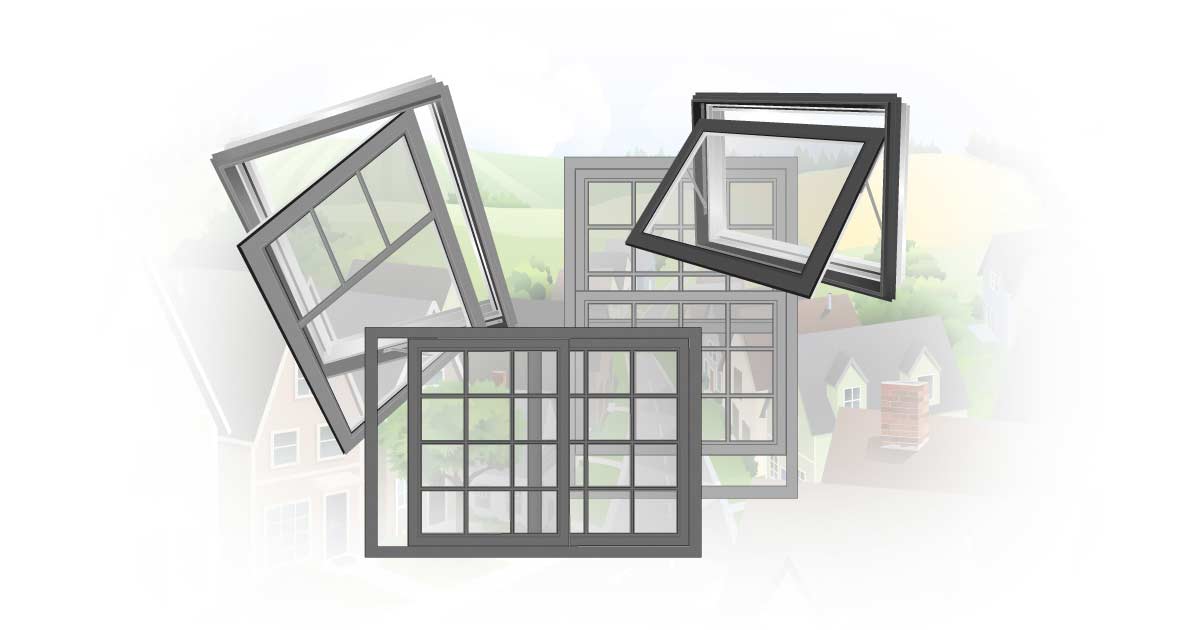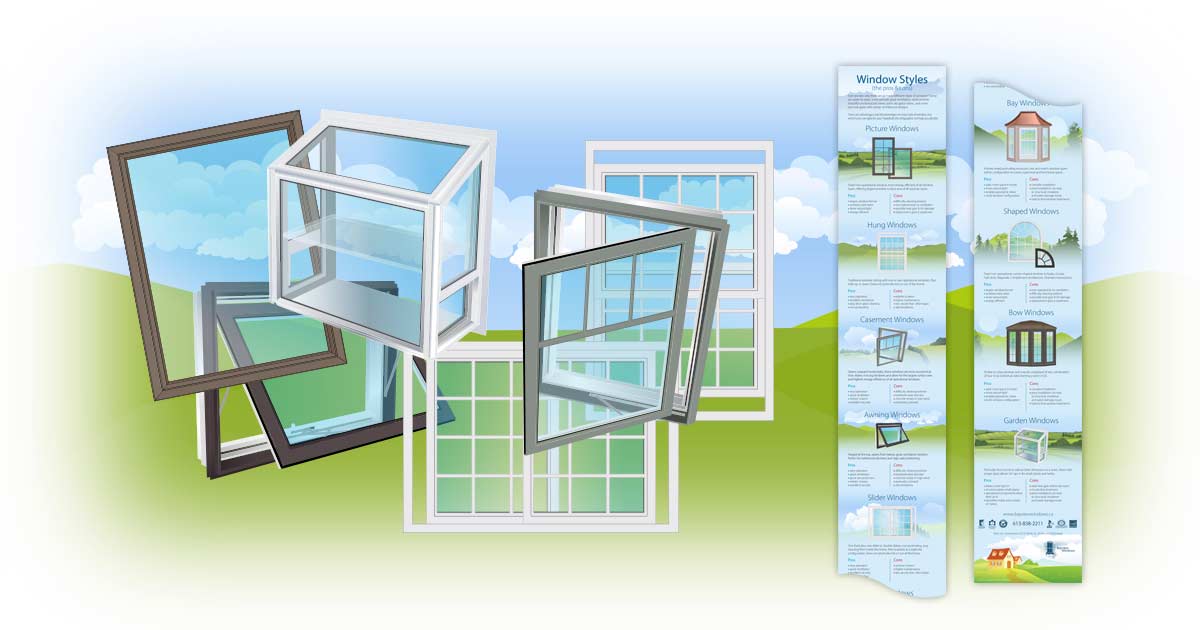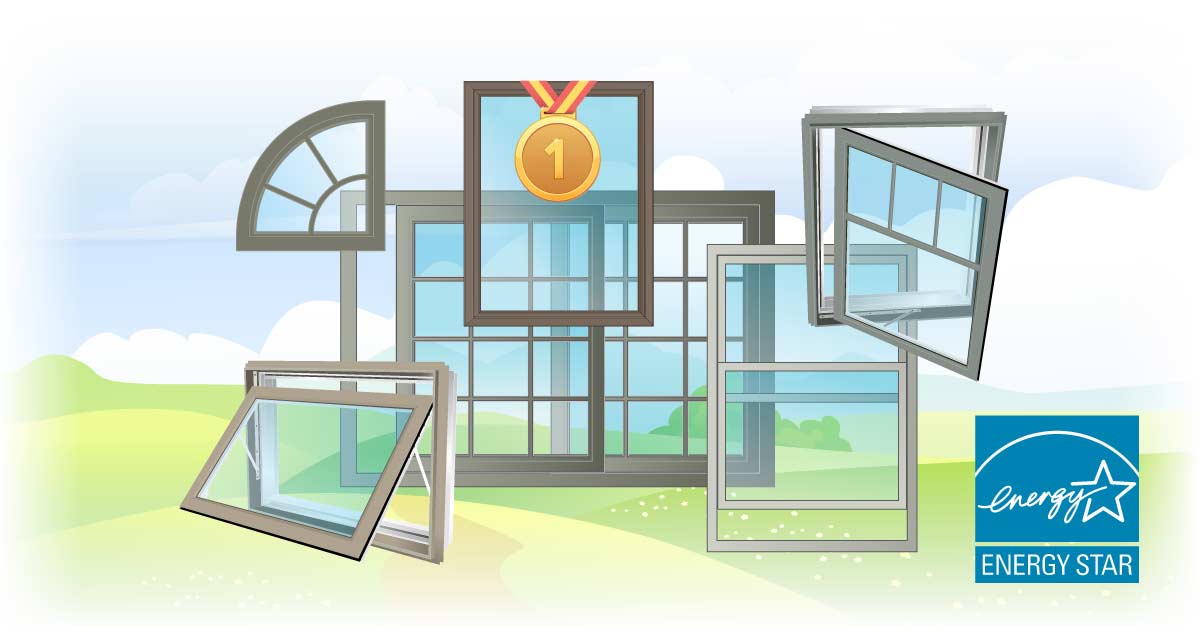Insights > Article > Posted: 2023-Nov-16, Updated: 2024-Jun-20
Window Style Comparison for Ottawa Homeowners: Casement, Hung, Sliding & Awning Windows Explained

In this article:
Casement Windows
Casement windows are the most popular, typical operational window used in residential homes today. They open out sideways up to 90 degrees. They are attractive, secure, and tend to provide better energy efficiency than hung, slider, and awning windows that are configured with standard glass and gas fills. These windows are almost always used at the front of a home.
Pros:
- The screen is on the inside of the window and is easily removed from inside the home.
- Most secure operational window available, typically incorporating a multi-locking mechanism controlled by one latch.
- Classy, clean look from the inside and outside.
- High energy efficiency due to a tight seal when closed.
- Durable and require less maintenance with quality hardware.
Cons:
- When left open in extreme wind conditions, these windows act as air brakes and tend to amplify the sound of the wind.
- When open, they can protrude into exterior high-traffic areas (decks, stairways, lawn) outside the home.
- Exterior window washing typically will have to be done from the outside. However, many window manufacturers have designed their windows so that when open at 90 degrees, you may be able to reach and wash the exterior, provided your arm is thin, and the window is not too wide.
- Generally more expensive than hung or sliding windows due to more complex hardware.
Hung Windows
Hung windows are the most traditional window of all operational windows. In the past, up until more recent history, they were the only operational window available and would appear on all sides of the home. They move vertically up and down.
Pros:
- Very easy to operate by hand, no crank handle required.
- Available in single-hung, double-hung, and tilt configurations to meet requirements.
- Double-hung windows can be cleaned (outside and inside) from within your home.
- An excellent solution when you don’t want a window protruding out of a home into an outdoor living area.
- Perfect for a classical, more traditional window look.
- The self-locking mechanism option makes it very easy to lock and unlock windows.
- Generally mid-range in cost, similar to sliding windows.
Cons:
- The screen is on the outside of the window and may take away from the aesthetics of a home.
- The screen is more prone to exterior environmental conditions, dirt, and projectiles.
- The area behind the screen is more prone to collecting dirt and dust.
- These windows are vertical in nature, so there are minimal height restrictions.
- With double-hung windows, both the upper and lower sash must be completely closed in order to lock.
- To make hung windows as efficient as other operational windows, the gas inside the pane must be upgraded from Argon to Krypton.
- Less energy-efficient than casement windows, but efficiency can be improved with upgrades like double glazing.
Sliding Windows
Sliding windows are very similar to hung windows, with the exception that they move horizontally rather than vertically. Slider windows are typically used in basements or on the sides and back of the home.
Pros:
- Very easy to operate by hand, no crank handle required.
- Available in single-slider, double-slider, and tilt configurations to meet requirements.
- Double-slider windows can be cleaned (both outside and inside) from within your home.
- An excellent solution when you don’t want a window protruding out of a home into an outdoor living area.
- The self-locking mechanism option makes it very easy to lock and unlock windows.
- Generally mid-range in cost, similar to hung windows.
Cons:
- The screen is on the outside of the window and may take away from the aesthetics of a home.
- The screen is more prone to exterior environmental conditions, dirt, and projectiles.
- The area behind the screen is more prone to collecting dirt and dust.
- These windows are horizontal in nature, so there are minimal width restrictions.
- With double-slider windows, both sashes must be completely closed in order to lock.
- Can’t lock windows in the open position.
- To make windows as efficient as other operational windows, the gas inside the pane must be upgraded from Argon to Krypton.
- Can be less efficient due to potential gaps between sashes; consider double glazing and better seals.
Awning Windows
Awning windows have increased in popularity over the years, especially for homes of a more modern nature. They are great for bathrooms and areas that require a higher window placement. They open and lock from the bottom, and when open, they create an almost roof-like appearance. They also provide great ventilation and are perfect for wet weather and moderate wind. Awning windows are often placed higher on a wall than other types of windows, and they are a great mix when a wall of windows is part of the home’s design.
Pros:
- Opening the window is a breeze with a standard twist crank or slide crank, depending on the manufacturer.
- An excellent solution for bathrooms (with a privacy glass option).
- Excellent ventilation.
- Better weather protection than most other types of operational windows.
- The screen is on the inside of the window and is easily removed from inside the home.
- Windows can be wide or thin.
- High energy efficiency due to a good seal and design that prevents rain entry.
- Great noise reduction due to a tight seal.
Cons:
- When open, they can protrude into exterior high-traffic areas (decks, stairways, lawn) outside the home.
- Typically requires at least two locking mechanisms on each side of the window.
- Generally more expensive than sliding or hung windows, but can vary based on size and features.
Summary
When choosing the right operational windows for your home, it's essential to weigh the pros and cons of each type.
Casement windows offer high security and energy efficiency but can be more costly and protrude into exterior spaces.
Hung windows provide a traditional look and easy operation, though they may require more maintenance and have height restrictions.
Sliding windows are practical for areas without vertical space limitations, but they can be less efficient and harder to secure.
Awning windows are ideal for higher placements and excellent weather protection, but can intrude into exterior spaces.
Related articles
Need more information?
Ready to transform your home with the perfect windows? Reach out to Bayview Windows today! Schedule a consultation to explore a variety of window styles tailored to your needs and budget. Let us help you elevate your home's beauty, efficiency, and comfort!


